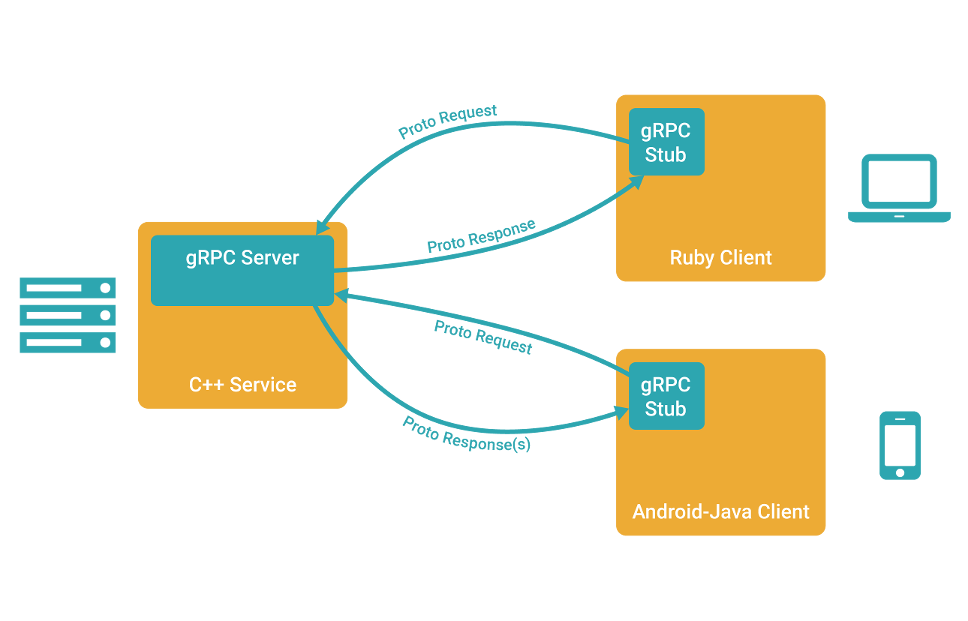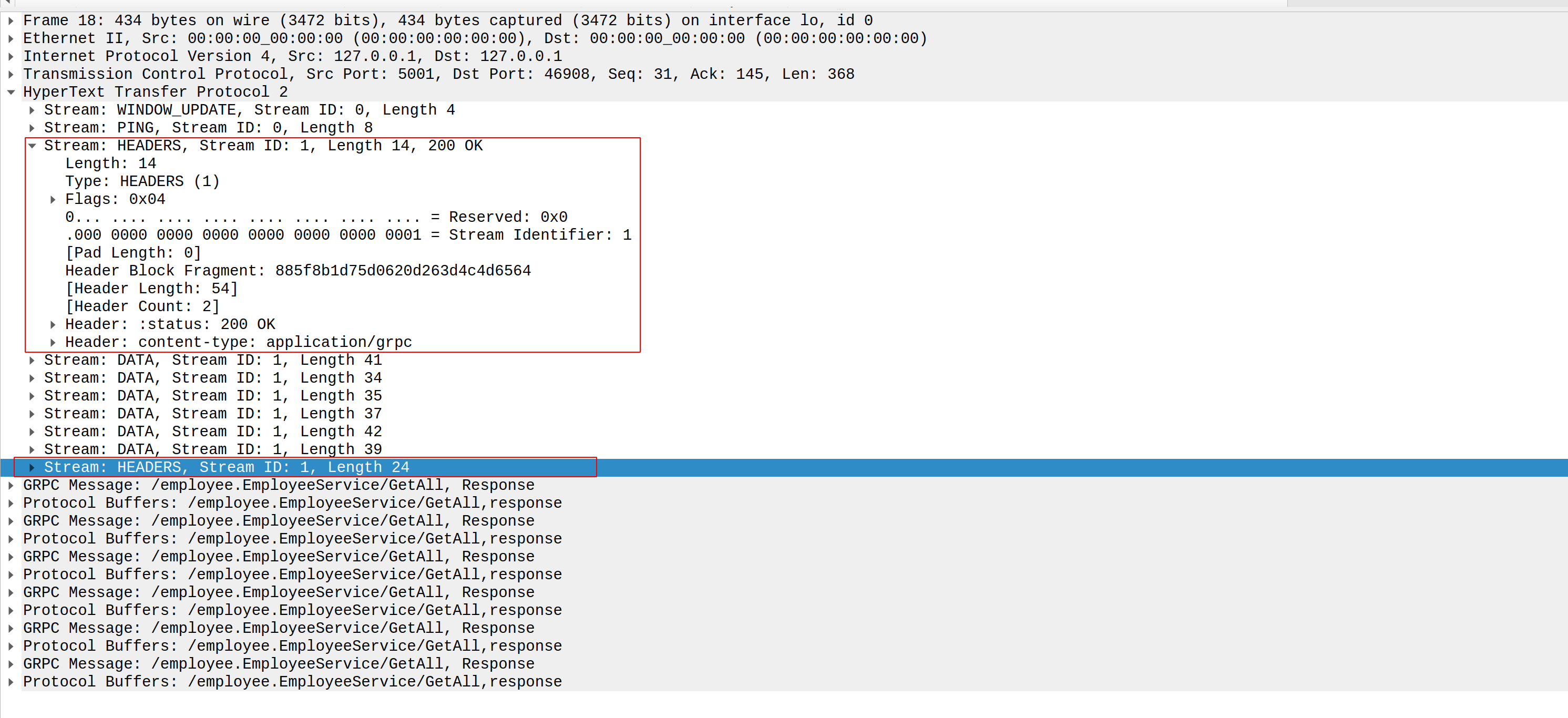gRPC Quick Start
RPC 全称 (Remote Procedure Call),远程过程调用,指的是一台计算机通过网络请求另一台计算机的上服务,从而不需要了解底层网络细节,RPC 是构建在已经存在的协议(TCP/IP,HTTP 等)之上的。gRPC 是云原生计算基金会(CNCF)项目,gRPC 一开始由 google 开发,是一款语言中立、平台中立的服务间通信框架,使用 gRPC 可以使得客户端像调用本地方法一样,调用远程主机提供的服务。可以在任何地方运行,它使客户端和服务器应用程序能够透明地进行通信,并使构建连接系统变得更加容易。
Context
- gRPC 默认采用 protocol buffer 作为 IDL (Interface Description Lanage) 接口描述语言,服务之间通信的数据序列化和反序列化也是基于 protocol buffer 的,因为 protocol buffer 的特殊性,所以 gRPC 框架是跨语言的通信框架(与编程语言无关性)
- gRPC 是基于 http2 协议实现,多路复用支持通过同一连接发送多个并行请求,双向全双工通信,用于同时发送客户端请求和服务器响应,内置流式传输使请求和响应能够异步流式传输大数据集
- gRPC 并没有直接实现负载均衡和服务发现的功能,但是已经提供了自己的设计思路。已经为命名解析和负载均衡提供了接口。
service Greeter {
/*
以下 分别是 服务端 推送流, 客户端 推送流 ,双向流。
*/
rpc GetStream (StreamReqData) returns (stream StreamResData){}
rpc PutStream (stream StreamReqData) returns (StreamResData){}
rpc AllStream (stream StreamReqData) returns (stream StreamResData){}
}Protocal Buffer
Profile
Protocol buffers 是一个灵活的、高效的、自动化的用于对结构化数据进行序列化的协议,与XML相比,Protocol buffers序列化后的码流更小、速度更快、操作更简单。
序列化(serialization、marshalling)的过程是指将数据结构或者对象的状态转换成可以存储(比如文件、内存)或者传输的格式(比如网络)。反向操作就是反序列化(deserialization、unmarshalling)的过程。
- 二十世纪九十年代后期,XML开始流行,它是一种人类易读的基于文本的编码方式,易于阅读和理解,但是失去了紧凑的基于字节流的编码的优势。
- JSON是一种更轻量级的基于文本的编码方式,经常用在client/server端的通讯中。
- YAML类似JSON,新的特性更强大,更适合人类阅读,也更紧凑。
除了上面这些和Protobuf,还有许许多多的序列化格式,比如Thrift、Avro、BSON、CBOR、MessagePack, 还有很多非跨语言的编码格式。项目gosercomp对比了各种go的序列化库,包括序列化和反序列的性能,以及序列化后的数据大小。总体来说Protobuf序列化和反序列的性能都是比较高的,编码后的数据大小也不错。
如果你并不希望一定要在传输过程中消息数据可读,那么可以用 Protocal Buffer 来代替 Json 。
Demo
syntax = "proto3"; // 版本定义
message SearchRequest {
int32 id = 1;
string name = 2;
bool rich = 3;
}第一行指定protobuf的版本,这里是以proto3格式定义。
第三行 message 表示定义了一个结构体,在这个结构体里,最常见的类型有以下几种
- 数值型 ,如 double, float, int32, int64 …
- 布尔型,bool 只有True和False
- 字符型,string 表示任意字符,但是长度不可超过2的32次方
- 字节型,bytes表示任意的byte数组序列,但是长度也不可以超过2的32次方,比如可以用来传递一个图片。
- 枚举型,enum 表示枚举。可独立在 message 之外。可通过
option allow_alias = true;给枚举定义别名。 - 字典型,map类型需要设置键和值的类型。
- Well-Known类型, Protobuf也提供了定义,比如Timestamp和Duration。这些定义被放在
github.com/golang/protobuf/ptypes/。
引入其它proto文件
import "other.proto";
import public "other2.proto";
import weak "other.proto";比较少使用的是public和weak关键字。默认情况下weak引入的文件允许不存在(missing),只为了google内部使用。public具有传递性,如果你在文件中通过public引入第三方的proto文件,那么引入你这个文件同时也会引入第三方的proto。
关键字:
- option :option可以用在proto的scope中,或者message、enum、service的定义中。一般常用的就是定义某语言生成后的package名,最常见的用法,如
option go_package = "xxx"; - repeated : 指定某一个字段可以存放同一个类型的多个数据, 相当于golang里的slice。可采用
[packed=true]以实现更高 效的编码。repeated int32 samples = 4 [packed=true]; - reserved : 保护某字段或定义,如在message中指定 数字1 被保护,或变量名 person 被保护。一般用来保护废弃的数字定义。如
reserved 5; reserved "salary";如果再使用5 或者 salary 则会报错。
demo
syntax = "proto3";
package my.project;
import "google/protobuf/timestamp.proto";
option go_package = "pb";
message PersonMessage {
int32 id = 1;
bool is_adult =2;
string name = 3;
float height = 4;
float weight = 5;
bytes avatar = 6;
string email = 7;
bool email_verified = 8;
repeated string phone_numbers = 9; // packed
Gender gender = 11;
Date birthday = 12;
repeated Address addresses = 13;
google.protobuf.Timestamp lastModified = 14;
enum Gender {
option allow_alias = true;
Not_SPECIFIED = 0;
MALE = 1;
FEMALE = 2;
MAN = 1;
WOMAN = 2;
}
message Address {
string province = 1;
string city = 2;
string zip_code = 3;
string street = 4;
string number = 5;
}
reserved 10, 20 to 100, 200 to max;
reserved "foo","bar";
}
message Date {
int32 year = 1;
int32 month = 2;
int32 day = 3;
}Golang protocol buffer
定义 .proto 文件后,使用命令
protoc --protoc_path src/ -go_out=src/ src/person.proto 生成golang 文件
定义一个pb
func NewPersonMessage() *pb.PersonMessage {
return &pb.PersonMessage{
Id: 1,
IsAdult: true,
Name: "Kiosk",
Height: 177,
Weight: 140,
Gender: pb.PersonMessage_MALE,
PhoneNumbers: []string{"15660018902","17610010111"},
Email: "kiosk007@foxmail.com",
}
}** 将 pb 写入文件 **
func writeToFile(filename string, pb proto.Message) error {
dataBytes, err := proto.Marshal(pb)
if err != nil { log.Fatalln("无法序列化") }
if err := ioutil.WriteFile(filename, dataBytes, 0644); err != nil {
log.Fatalln("无法写入文件")
}
log.Println("成功写入到文件")
return nil
}
func main() {
pm := NewPersonMessage()
_ = writeToFile("person.bin",pm)
}** 从文件读出 pb **
func readFromFile(filename string, pb proto.Message) error {
dataBytes, err := ioutil.ReadFile(filename)
if err != nil { log.Fatalln("读取文件错误",err.Error()) }
if err := proto.Unmarshal(dataBytes, pb); err != nil {
log.Fatalln("反序列化失败")
}
return nil
}
func main() {
pm := &demo.PersonMessage{}
_ = readFromFile("person.bin", pm)
fmt.Println(pm)
}pb 转 json && json 转 pb
func toJson(pb proto.Message) string {
marshaler := jsonpb.Marshaler{Indent: " "}
str ,err := marshaler.MarshalToString(pb)
if err != nil { log.Fatalln("转换为JSON时发生错误",err.Error()) }
return str
}
func fromJson(in string, pb proto.Message) error {
return jsonpb.UnmarshalString(in, pb)
}gogo库
虽然官方库 golang/protobu 提供了对Protobuf的支持,但是使用最多还是第三方实现的库gogo/protobuf。
gogo库基于官方库开发,增加了很多的功能,包括:
- 快速的序列化和反序列化
- 更规范的Go数据结构
- goprotobuf兼容
- 可选择的产生一些辅助方法,减少使用中的代码输入
- 可以选择产生测试代码和benchmark代码
- 其它序列化格式
更多参考github: http://github.com/gogo/protobuf
gRPC Start
进入主题了, gRPC 是Google发布的基于HTTP 2.0传输层协议承载的高性能开源软件框架。提供了支持多种编程语言的、对网络设备进行配置和纳管的方法。
RPC是远程函数调用,因此每次调用的函数参数和返回值不能太大,否则将严重影响每次调用的响应时间。因此传统的RPC方法调用对于上传和下载较大数据量场景并不适合。同时传统RPC模式也不适用于对时间不确定的订阅和发布模式。为此,gRPC框架针对服务器端和客户端分别提供了流特性。 支持 服务端 推送流, 客户端 推送流 ,双向流。

install
gRPC要求 Go 版本 >= 1.6
- 安装grpc
$ go get -u -v google.golang.org/grpc- 安装 Protocol Buffers v3、protoc-gen-go:
$ go get -v -u github.com/golang/protobuf/protoc-gen-go- 生成grpc代码
$ protoc -I. --go_out=plugins=grpc:. helloworld.protodefine proto
gRPC需要事先定义proto文件,如下所示。定义完成后需要执行命令 protoc --go_out=plugins=grpc:. message.proto 生成相关的go语言代码。更多详细的操作参考官方例子 Quick start - gRPC
点击查看
gRPC server
gRPC服务的启动流程和标准库的RPC服务启动流程类似:
const port = ":5001"
func main() {
listen, err := net.Listen("tcp", port)
if err != nil { log.Fatalln(err.Error() }
var options []grpc.ServerOption
options = append(options, grpc.HeaderTableSize(2048))
server := grpc.NewServer(options...)
pb.RegisterEmployeeServiceServer(server, new(example.EmployeeService))
log.Printf("gRPC Server started ...\n Listen on port %s", port)
_ = server.Serve(listen)
}- 这里设置监听在 tcp 的 5001 端口.
grpc.ServerOption可以设置gRPC的服务端监听参数, 这里我仅设置了 H2 的 header 动态表大小。除此之外,如设置 TLS证书载入:grpc.Creds(c credentials.TransportCredentials)。 最大并发数、收发最大消息Size等等,详见 https://godoc.org/google.golang.org/grpc#ServerOptionpb.RegisterEmployeeServiceServer是proto生成的 message.pb.go 提供的服务端注册方法。example.EmployeeService是我们后面手动创建的空结构,后面的函数方法都需要基于这个空结构实现。- server.Serve 将监听套接字传入。
实现 EmployeeService
service EmployeeService {
rpc GetByNo(GetByNoRequest) returns (EmployeeResponse); // 一元请求
rpc GetAll(GetAllRequest) returns (stream EmployeeResponse); // 客户端推送流
rpc AddPhoto(stream AddPhotoRequest) returns (AddPhotoResponse); // 服务端推送流
rpc SaveAll(stream EmployeeRequest) returns (stream EmployeeResponse); // 双向流
}
对应的pb生成代码
// EmployeeServiceServer is the server API for EmployeeService service.
type EmployeeServiceServer interface {
GetByNo(context.Context, *GetByNoRequest) (*EmployeeResponse, error)
GetAll(*GetAllRequest, EmployeeService_GetAllServer) error
AddPhoto(EmployeeService_AddPhotoServer) error
SaveAll(EmployeeService_SaveAllServer) error
}首先需要定义 type EmployeeService struct {} 后面的所有方法都需要基于这个实现,这个也是服务端注册的参数。
- **一元请求
GetByNo()**
func (s *EmployeeService) GetByNo(ctx context.Context, request *pb.GetByNoRequest) (*pb.EmployeeResponse, error) {
log.Println(request.No)
for _,e := range employees {
if request.No == e.No {
return &pb.EmployeeResponse{
Employee: &e,
}, nil
}
}
return nil, errors.New("the employee does not exist")
}请求参数是 GetByNoRequest, 通过上面的pb定义得知,这个message是有一个No参数。所以可以取出来当请求参数。返回的参数是EmployeeResponse,通过pb定义得知,其返回参数是 Employee 对象。
- 服务端返回流
GetAll()
func (s *EmployeeService) GetAll(request *pb.GetAllRequest, stream pb.EmployeeService_GetAllServer) error {
for _,e := range employees {
err := stream.Send(&pb.EmployeeResponse{
Employee: &e,
})
if err != nil {
log.Println(err.Error())
}
}
return nil
}注意,返回的参数是一条流,其流发送的方法也可以使用Send函数,这里是一个循环,将employee对象循环写入这条流中。
type EmployeeService_GetAllServer interface {
Send(*EmployeeResponse) error
grpc.ServerStream
}- 客户端推送流
AddPhoto()
func (s *EmployeeService) AddPhoto(stream pb.EmployeeService_AddPhotoServer) error {
md, ok := metadata.FromIncomingContext(stream.Context())
if ok { fmt.Printf("employee: %s", md["no"][0]) }
var images []byte
for {
data, err := stream.Recv()
if err == io.EOF {
fmt.Printf("File Size %d\n", len(images))
return stream.SendAndClose(&pb.AddPhotoResponse{IsOk: true})
}
if err != nil {
return err
}
fmt.Printf("File received: %d\n", len(data.Data))
images = append(images, data.Data...)
}
}这个函数实现了客户端将一张图片拆分成 bytes 再一点一点发送给服务端的demo。读到EOF表示成功读完。Data正是在 pb 里定义的AddPhotoRequest的客户端请求内容。
- 双向流
SaveAll()
func (s *EmployeeService) SaveAll(stream pb.EmployeeService_SaveAllServer) error {
for {
empReq, err := stream.Recv()
if err == io.EOF {
break
}else if err != nil {
return err
}
employees = append(employees, *empReq.Employee)
time.Sleep(1000 * time.Microsecond)
_ = stream.Send(&pb.EmployeeResponse{Employee: empReq.Employee})
}
for _ , emp := range employees {
fmt.Println(emp)
}
return nil
}在这个方法中,服务端每读一份数据,休眠100ms,再将读入的数据原封不动的返回给客户端。
gRPC client
func main() {
var options []grpc.DialOption
options = append(options, grpc.WithInsecure())
conn, err := grpc.Dial("localhost" + port, options...)
if err != nil {
log.Fatalln("can't dial server " + err.Error())
}
defer conn.Close()
client := pb.NewEmployeeServiceClient(conn)
// GetByNo(client)
// getAll(client)
//addPhoto(client)
saveAll(client)
}客户端也有一个类似Server端的grpc.DialOption, 这里因为服务端没有使用证书,所以客户端必须添加 WithInsecure 选项。调用 pb.NewEmployeeServiceClient(conn) 会返回一个 Client employeeServiceClient。
type employeeServiceClient struct {
cc grpc.ClientConnInterface
}这个client拥有之前定义的客户端可调用的 RPC 方法。如下:
// For semantics around ctx use and closing/ending streaming RPCs, please refer to https://godoc.org/google.golang.org/grpc#ClientConn.NewStream.
type EmployeeServiceClient interface {
GetByNo(ctx context.Context, in *GetByNoRequest, opts ...grpc.CallOption) (*EmployeeResponse, error)
GetAll(ctx context.Context, in *GetAllRequest, opts ...grpc.CallOption) (EmployeeService_GetAllClient, error)
AddPhoto(ctx context.Context, opts ...grpc.CallOption) (EmployeeService_AddPhotoClient, error)
SaveAll(ctx context.Context, opts ...grpc.CallOption) (EmployeeService_SaveAllClient, error)
}实现 Client 调用
- 一元请求
GetByNo()
func GetByNo(client pb.EmployeeServiceClient) {
res, err := client.GetByNo(context.Background(), &pb.GetByNoRequest{No: 1996})
if err != nil {
log.Fatalln(err.Error())
}
fmt.Println(res.Employee)
}传入的参数拥有 GetByNo() 这个方法,直接调用即可。
抓包可以看到,整个gRPC的调用过程是基于HTTP2的, 本质是发起了一个H2的POST请求, 和传统H2不同的是,response 的 Header帧有2个,结尾处还有一个。第2个表示调用结束。
Stream: HEADERS, Stream ID: 1, Length 80, POST /employee.EmployeeService/GetByNo
Length: 80
Type: HEADERS (1)
Flags: 0x04
0... .... .... .... .... .... .... .... = Reserved: 0x0
.000 0000 0000 0000 0000 0000 0000 0001 = Stream Identifier: 1
[Pad Length: 0]
Header Block Fragment: 3fe10f8386459960b4d741fd14abe0a6ba0fe8a5dc5b3b98…
[Header Length: 202]
[Header Count: 8]
Header table size update
Header: :method: POST
Header: :scheme: http
Header: :path: /employee.EmployeeService/GetByNo
Header: :authority: localhost:5001
Header: content-type: application/grpc
Header: user-agent: grpc-go/1.33.2
Header: te: trailers
- 服务端返回流
GetAll()
func getAll(client pb.EmployeeServiceClient) {
stream, err := client.GetAll(context.Background(), &pb.GetAllRequest{})
if err != nil {
log.Fatalln(err.Error())
}
for {
res, err := stream.Recv()
if err == io.EOF {
return
}else if err != nil {
log.Fatalln(err.Error())
}
fmt.Println(res.Employee)
}
}服务端返回的流可以使用 stream.Recv() 循环接收。

- 客户端推送流
AddPhoto()
func addPhoto(client pb.EmployeeServiceClient) {
imgFile,err := os.Open("/home/kiosk007/Pictures/2020-09-22_00-15.png")
if err != nil {
log.Fatalln(err.Error())
}
defer imgFile.Close()
md := metadata.New(map[string]string{"no": "1996"})
context := context.Background()
context = metadata.NewOutgoingContext(context, md)
stream,err := client.AddPhoto(context)
if err != nil {
log.Fatalln(err.Error())
}
for {
chunk := make([]byte, 128*24)
chunkSize,err := imgFile.Read(chunk)
if err == io.EOF {
break
}
if err != nil {
log.Fatalln(err.Error())
}
if chunkSize < len(chunk) {
chunk = chunk[:chunkSize]
}
_ = stream.Send(&pb.AddPhotoRequest{Data: chunk})
}
res, err := stream.CloseAndRecv()
if err != nil {
log.Fatalln(err.Error())
}
fmt.Println(res.IsOk)
}客户端推送流实现了一个照片流式上传的功能。每次发送 3072字节 (128*24)。
- 双向流
SaveAll()
func saveAll(client pb.EmployeeServiceClient) {
employees := []pb.Employee{
pb.Employee{
Id: 300,
No: 5001,
FirstName: "Monica",
LastName: "Geller",
MonthSalary: 15500,
Status: pb.EmployeeStatus_RETIRED,
LastModified: ×tamp.Timestamp{ Seconds: time.Now().Unix() },
},
pb.Employee{
Id: 301,
No: 5002,
FirstName: "Joey",
LastName: "Green",
MonthSalary: 200,
Status: pb.EmployeeStatus_RESIGNED,
LastModified: ×tamp.Timestamp{ Seconds: time.Now().Unix() },
},
}
stream, err := client.SaveAll(context.Background())
if err != nil {
log.Fatalln(err.Error())
}
finishChannel := make(chan struct{})
go func() {
for {
res,err := stream.Recv()
if err == io.EOF {
finishChannel <- struct{}{}
break
}else if err != nil {
log.Fatalln(err.Error())
}
fmt.Println(res.Employee)
}
}()
for _,e := range employees {
err := stream.Send(&pb.EmployeeRequest{Employee: &e})
time.Sleep(500 * time.Microsecond)
if err != nil {
log.Fatalln(err.Error())
}
}
_ = stream.CloseSend()
<- finishChannel
}参考: